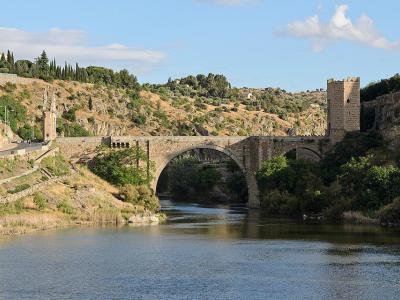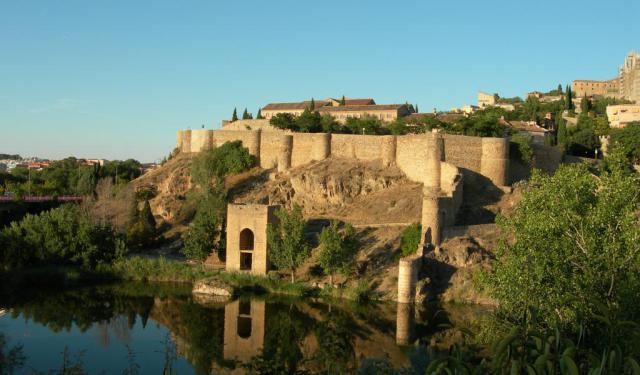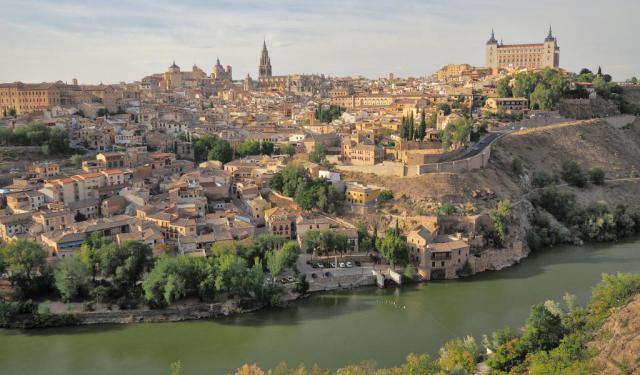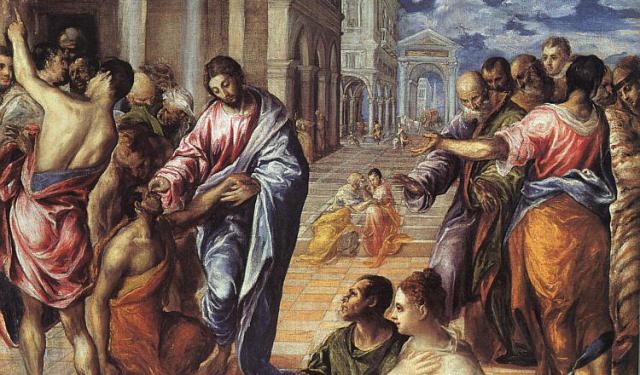Puente de Alcantara (Alcantara Bridge), Toledo
The Alcantara Bridge is a historical landmark and an impressive feat of engineering located in Toledo. This ancient bridge spans the Tagus River and was built by the Romans after they founded the city. The name "Alcántara" is derived from the Arabic word "al-qanţarah," meaning "arch," which reflects the bridge's impressive architectural design.
Located at the foot of the Castillo de San Servando, the Puente de Alcántara was one of the few entrances for pilgrims into the city during the Middle Ages. It currently features two arches, but there is evidence that it had three arches when it was originally constructed. Over time, the bridge suffered damage and was rebuilt, with a third arch disappearing and being reduced to a gate with a horseshoe arch during the 10th century.
During the reign of Alfonso X of Castile, the bridge suffered serious damage and was rebuilt. The western tower, which still stands today, belongs to this period and was later decorated under the reign of the Catholic Monarchs, whose arms decorate its walls. The pomegranate fruit, which was the emblem of Granada, is missing from the walls because the Reconquista had not been completed at that time.
The eastern tower, however, was replaced by a Baroque triumphal arch in 1721 due to its ruinous state. This arch remains a testament to the bridge's long and varied history.
Despite its age, the Puente de Alcántara has stood the test of time and remains a remarkable example of Roman engineering. It was declared a national cultural monument in 1921, and it continues to attract visitors from all over the world who come to marvel at its beauty and historical significance.
Located at the foot of the Castillo de San Servando, the Puente de Alcántara was one of the few entrances for pilgrims into the city during the Middle Ages. It currently features two arches, but there is evidence that it had three arches when it was originally constructed. Over time, the bridge suffered damage and was rebuilt, with a third arch disappearing and being reduced to a gate with a horseshoe arch during the 10th century.
During the reign of Alfonso X of Castile, the bridge suffered serious damage and was rebuilt. The western tower, which still stands today, belongs to this period and was later decorated under the reign of the Catholic Monarchs, whose arms decorate its walls. The pomegranate fruit, which was the emblem of Granada, is missing from the walls because the Reconquista had not been completed at that time.
The eastern tower, however, was replaced by a Baroque triumphal arch in 1721 due to its ruinous state. This arch remains a testament to the bridge's long and varied history.
Despite its age, the Puente de Alcántara has stood the test of time and remains a remarkable example of Roman engineering. It was declared a national cultural monument in 1921, and it continues to attract visitors from all over the world who come to marvel at its beauty and historical significance.
Want to visit this sight? Check out these Self-Guided Walking Tours in Toledo. Alternatively, you can download the mobile app "GPSmyCity: Walks in 1K+ Cities" from Apple App Store or Google Play Store. The app turns your mobile device to a personal tour guide and it works offline, so no data plan is needed when traveling abroad.
Puente de Alcantara (Alcantara Bridge) on Map
Sight Name: Puente de Alcantara (Alcantara Bridge)
Sight Location: Toledo, Spain (See walking tours in Toledo)
Sight Type: Attraction/Landmark
Guide(s) Containing This Sight:
Sight Location: Toledo, Spain (See walking tours in Toledo)
Sight Type: Attraction/Landmark
Guide(s) Containing This Sight:
Walking Tours in Toledo, Spain
Create Your Own Walk in Toledo
Creating your own self-guided walk in Toledo is easy and fun. Choose the city attractions that you want to see and a walk route map will be created just for you. You can even set your hotel as the start point of the walk.
Toledo's Ancient Walls, Gates and Bridges
Other than its signature “Toledo steel”, the Spanish city of Toledo is known for its historic architecture, particularly the ancient mammoth fortifications – a testament to the strength of the city that has maintained its borders for well over a thousand years.
Toledo's soaring walls were first built by the Romans in the 3rd century AD and then further expanded, over the following... view more
Tour Duration: 1 Hour(s)
Travel Distance: 2.1 Km or 1.3 Miles
Toledo's soaring walls were first built by the Romans in the 3rd century AD and then further expanded, over the following... view more
Tour Duration: 1 Hour(s)
Travel Distance: 2.1 Km or 1.3 Miles
Toledo Introduction Walking Tour
Roman historian Livy didn’t bother with flattery. To him, Toledo was “a small city, but fortified by location”-and he wasn’t wrong. Apart from its governance over the Tagus River, the city has long been known as the “City of the Three Cultures”-a place where Christianity, Islam, and Judaism all left visible marks, even if coexistence was not always peaceful. Its name comes from the... view more
Tour Duration: 2 Hour(s)
Travel Distance: 3.2 Km or 2 Miles
Tour Duration: 2 Hour(s)
Travel Distance: 3.2 Km or 2 Miles
El Greco's Masterpieces
Domnnikos Theotokopoulos, most widely known as El Greco or "The Greek," was a Greek painter, sculptor, and architect of the Spanish Renaissance. El Greco was well ahead of his time. His dramatic and expressionistic style is regarded as a precursor of both Expressionism and Cubism of the 20th century.
El Greco was born in Crete, Greece, and studied painting in Italy. In 1577, he... view more
Tour Duration: 1 Hour(s)
Travel Distance: 2.0 Km or 1.2 Miles
El Greco was born in Crete, Greece, and studied painting in Italy. In 1577, he... view more
Tour Duration: 1 Hour(s)
Travel Distance: 2.0 Km or 1.2 Miles






